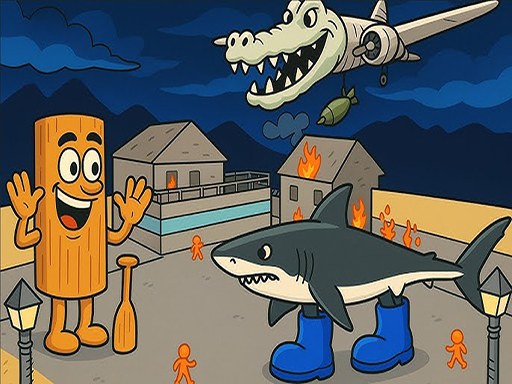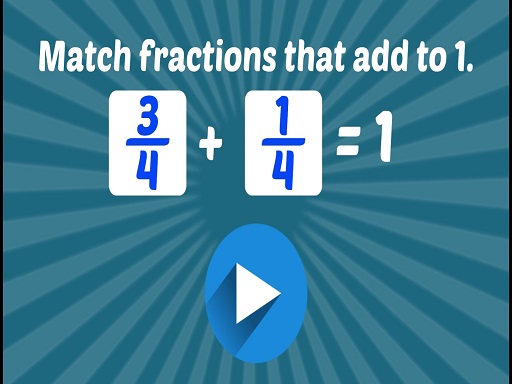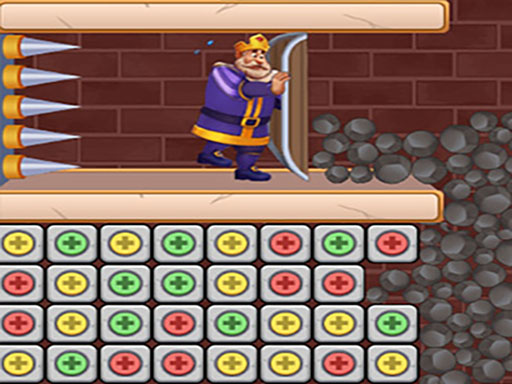Ricochet Logic
About Ricochet Logic
Okay, so listen, I’ve got to tell you about this game. Seriously, you know how I’m always digging around for those hidden gems, the ones that don’t scream for attention but then completely devour your free time? Well, I stumbled upon something called Ricochet Logic, and honestly, it’s been living rent-free in my head ever since. I mean, when I first saw it, I was like, “Oh, another brick breaker, huh?” And then, like a fool, I dismissed it. But man, was I wrong. So, so wrong.
It’s an HTML5 game, which, you know, sometimes makes you think it’s going to be a quick, shallow distraction. And in a way, it is a quick distraction, but it’s anything *but* shallow. What I love about games like this is how they trick you. They present this incredibly simple facade, almost minimalist to a fault, and then they just slowly, insidiously, pull you into this vortex of pure, unadulterated, strategic satisfaction. Ricochet Logic does that with a finesse I haven’t seen in ages.
You start, right? And it’s just a screen, clean and uncluttered, with a bunch of numbered bricks arranged in rows, and your little ball launcher at the bottom. The instructions are practically non-existent because you don’t need them. You just tap your finger on the screen, drag to aim, and release to shoot. Simple. Too simple, you might think. But then you fire that first ball, and it bounces. And that’s where the magic begins.
There’s something incredibly primal about watching a perfectly aimed shot carom off a wall, hit a brick, then another, then another. It’s not just about hitting bricks; it’s about *predicting* the trajectory. It’s about understanding angles, about visualizing the path your ball will take three, four, five bounces down the line. You start to see the game not as a random series of events, but as a meticulously crafted physics puzzle. What’s fascinating is how quickly your brain adapts. You’ll find yourself unconsciously calculating angles, eyeing those sweet spots that will send your ball ricocheting into a cluster of high-value bricks. The brilliant thing about this is that the game never explicitly tells you to do this; it just *invites* you to discover it. It’s an organic learning process that feels incredibly rewarding.
I remember one session, I was just casually playing, maybe five minutes in, thinking I’d play a round or two and move on. I fired a ball, and it hit a corner brick, then bounced perfectly into a narrow gap between two other bricks, clearing them both. The sound design is subtle but perfect – a satisfying *thwack* as a brick shatters, a gentle *ping* as your ball hits a wall. It’s enough to give you feedback without being overwhelming. But then, as that ball was still bouncing, I saw it: a shimmering gold circle appear among the bricks. I instinctively aimed my next shot to collect it. And that’s when it hit me.
The gold circles. Oh, the gold circles are the real game-changer. You collect one, and suddenly, your next shot isn't just *one* ball; it's *two*. Collect another, and it's three. And this isn't just about getting more firepower; it's about chaining. You’ll fire a shot, and as those balls are bouncing around, destroying bricks, you’re already planning your *next* shot, trying to predict where a gold circle will appear, where the most advantageous cluster of bricks will be. The real magic happens when you manage to collect several gold circles in a single round. You launch your shot, and suddenly, the screen erupts. Dozens of balls are flying everywhere, a chaotic symphony of destruction. It’s pure euphoria. You can almost feel the tension in your shoulders release as you watch the cascading destruction, each ball contributing to the glorious, inevitable demise of the brick formation.
And that’s where the "endless ball chain" comes in. It’s not just a fancy phrase; it’s a tangible, exhilarating goal. You're constantly trying to set up that perfect shot that will not only clear a path but also collect enough gold circles to keep the chain going, to keep the balls multiplying. There are moments when you’re down to your last few balls, the bricks are perilously close to the bottom of the screen, and you think it’s over. But then, with a stroke of luck or, more often, a perfectly executed, desperate shot, you collect a gold circle, and suddenly, you’re back in the game, more balls flying, hope rekindled. That feeling of snatching victory from the jaws of defeat? That’s what keeps you coming back. It’s that visceral rush of adrenaline when you pull off a seemingly impossible recovery.
The stakes are simple but effective: crush as many bricks as possible before they fall to the ground. It’s a constant race against the clock, or rather, against the relentless descent of the brick formation. Every few shots, the bricks drop a row, adding to the pressure. This makes every decision critical. Do you go for the high-value bricks at the top, knowing they’ll take more hits but clear more space? Or do you focus on the lower rows, just trying to survive a little longer? What’s interesting is how your strategy evolves. In the beginning, you’re just smashing bricks. But as you play more, you start thinking several moves ahead. You learn to prioritize, to identify the bricks that, if cleared, will open up a massive chain reaction. You start to see patterns, weaknesses in the brick formations. This makes me wonder how much of the level design is procedural and how much is subtly guided to create these satisfying breakthrough moments.
Honestly, I’ve always been drawn to games that offer a deep strategic layer beneath a simple exterior. Think about something like Tetris, or even a classic arcade game like Space Invaders. They’re easy to pick up, but mastering them is a journey. Ricochet Logic fits right into that category. It’s not about flashy graphics or an intricate story; it’s about the pure, unadulterated joy of problem-solving and pattern recognition. It’s about that quiet satisfaction when a strategy finally clicks into place, when you see the path, you execute the shot, and the screen just *explodes* with satisfying destruction.
In my experience, the best moments come when you lose yourself completely. I mean, I’ve sat down to play for "just five minutes" before dinner, and the next thing I know, my partner is calling me for the third time, and an hour has vanished. That’s the kind of time-killer Ricochet Logic is. It’s not just killing time; it’s *absorbing* it. Your mind gets into this incredible flow state where everything else just fades away. It’s just you, the balls, the bricks, and the endless, fascinating puzzle of angles and trajectories. You can almost feel your brain humming, processing the physics, anticipating the bounces, strategizing the next move. It’s a meditative experience, really, despite the constant action.
There's something magical about how this game achieves so much with so little. The minimalism isn't a lack of effort; it's a deliberate design choice that forces you to focus on the core mechanics. There are no distractions, just pure, unadulterated gameplay. It’s the kind of game that reminds you why you fell in love with gaming in the first place – that simple, elegant challenge that keeps your mind engaged and your fingers tapping.
So, yeah, if you're looking for something that’s deceptively simple, incredibly addictive, and just melts away the hours in the most satisfying way possible, you absolutely have to check out Ricochet Logic. Don't let the "brick breaker" label fool you. It’s so much more than that. It’s a masterclass in elegant game design, a true champion of time-killers, and honestly, one of the most satisfying little discoveries I’ve made in a long, long time. Just wait until you get that first endless ball chain going. You’ll know exactly what I mean. You’ll be hooked. I promise.
It’s an HTML5 game, which, you know, sometimes makes you think it’s going to be a quick, shallow distraction. And in a way, it is a quick distraction, but it’s anything *but* shallow. What I love about games like this is how they trick you. They present this incredibly simple facade, almost minimalist to a fault, and then they just slowly, insidiously, pull you into this vortex of pure, unadulterated, strategic satisfaction. Ricochet Logic does that with a finesse I haven’t seen in ages.
You start, right? And it’s just a screen, clean and uncluttered, with a bunch of numbered bricks arranged in rows, and your little ball launcher at the bottom. The instructions are practically non-existent because you don’t need them. You just tap your finger on the screen, drag to aim, and release to shoot. Simple. Too simple, you might think. But then you fire that first ball, and it bounces. And that’s where the magic begins.
There’s something incredibly primal about watching a perfectly aimed shot carom off a wall, hit a brick, then another, then another. It’s not just about hitting bricks; it’s about *predicting* the trajectory. It’s about understanding angles, about visualizing the path your ball will take three, four, five bounces down the line. You start to see the game not as a random series of events, but as a meticulously crafted physics puzzle. What’s fascinating is how quickly your brain adapts. You’ll find yourself unconsciously calculating angles, eyeing those sweet spots that will send your ball ricocheting into a cluster of high-value bricks. The brilliant thing about this is that the game never explicitly tells you to do this; it just *invites* you to discover it. It’s an organic learning process that feels incredibly rewarding.
I remember one session, I was just casually playing, maybe five minutes in, thinking I’d play a round or two and move on. I fired a ball, and it hit a corner brick, then bounced perfectly into a narrow gap between two other bricks, clearing them both. The sound design is subtle but perfect – a satisfying *thwack* as a brick shatters, a gentle *ping* as your ball hits a wall. It’s enough to give you feedback without being overwhelming. But then, as that ball was still bouncing, I saw it: a shimmering gold circle appear among the bricks. I instinctively aimed my next shot to collect it. And that’s when it hit me.
The gold circles. Oh, the gold circles are the real game-changer. You collect one, and suddenly, your next shot isn't just *one* ball; it's *two*. Collect another, and it's three. And this isn't just about getting more firepower; it's about chaining. You’ll fire a shot, and as those balls are bouncing around, destroying bricks, you’re already planning your *next* shot, trying to predict where a gold circle will appear, where the most advantageous cluster of bricks will be. The real magic happens when you manage to collect several gold circles in a single round. You launch your shot, and suddenly, the screen erupts. Dozens of balls are flying everywhere, a chaotic symphony of destruction. It’s pure euphoria. You can almost feel the tension in your shoulders release as you watch the cascading destruction, each ball contributing to the glorious, inevitable demise of the brick formation.
And that’s where the "endless ball chain" comes in. It’s not just a fancy phrase; it’s a tangible, exhilarating goal. You're constantly trying to set up that perfect shot that will not only clear a path but also collect enough gold circles to keep the chain going, to keep the balls multiplying. There are moments when you’re down to your last few balls, the bricks are perilously close to the bottom of the screen, and you think it’s over. But then, with a stroke of luck or, more often, a perfectly executed, desperate shot, you collect a gold circle, and suddenly, you’re back in the game, more balls flying, hope rekindled. That feeling of snatching victory from the jaws of defeat? That’s what keeps you coming back. It’s that visceral rush of adrenaline when you pull off a seemingly impossible recovery.
The stakes are simple but effective: crush as many bricks as possible before they fall to the ground. It’s a constant race against the clock, or rather, against the relentless descent of the brick formation. Every few shots, the bricks drop a row, adding to the pressure. This makes every decision critical. Do you go for the high-value bricks at the top, knowing they’ll take more hits but clear more space? Or do you focus on the lower rows, just trying to survive a little longer? What’s interesting is how your strategy evolves. In the beginning, you’re just smashing bricks. But as you play more, you start thinking several moves ahead. You learn to prioritize, to identify the bricks that, if cleared, will open up a massive chain reaction. You start to see patterns, weaknesses in the brick formations. This makes me wonder how much of the level design is procedural and how much is subtly guided to create these satisfying breakthrough moments.
Honestly, I’ve always been drawn to games that offer a deep strategic layer beneath a simple exterior. Think about something like Tetris, or even a classic arcade game like Space Invaders. They’re easy to pick up, but mastering them is a journey. Ricochet Logic fits right into that category. It’s not about flashy graphics or an intricate story; it’s about the pure, unadulterated joy of problem-solving and pattern recognition. It’s about that quiet satisfaction when a strategy finally clicks into place, when you see the path, you execute the shot, and the screen just *explodes* with satisfying destruction.
In my experience, the best moments come when you lose yourself completely. I mean, I’ve sat down to play for "just five minutes" before dinner, and the next thing I know, my partner is calling me for the third time, and an hour has vanished. That’s the kind of time-killer Ricochet Logic is. It’s not just killing time; it’s *absorbing* it. Your mind gets into this incredible flow state where everything else just fades away. It’s just you, the balls, the bricks, and the endless, fascinating puzzle of angles and trajectories. You can almost feel your brain humming, processing the physics, anticipating the bounces, strategizing the next move. It’s a meditative experience, really, despite the constant action.
There's something magical about how this game achieves so much with so little. The minimalism isn't a lack of effort; it's a deliberate design choice that forces you to focus on the core mechanics. There are no distractions, just pure, unadulterated gameplay. It’s the kind of game that reminds you why you fell in love with gaming in the first place – that simple, elegant challenge that keeps your mind engaged and your fingers tapping.
So, yeah, if you're looking for something that’s deceptively simple, incredibly addictive, and just melts away the hours in the most satisfying way possible, you absolutely have to check out Ricochet Logic. Don't let the "brick breaker" label fool you. It’s so much more than that. It’s a masterclass in elegant game design, a true champion of time-killers, and honestly, one of the most satisfying little discoveries I’ve made in a long, long time. Just wait until you get that first endless ball chain going. You’ll know exactly what I mean. You’ll be hooked. I promise.
Enjoy playing Ricochet Logic online for free on Coduxa. This Puzzle game offers amazing gameplay and stunning graphics. No downloads required, play directly in your browser!
How to Play
Swipe your finger to throw the balls and break the bricks Every brick has numbers hit the bricks as many times as the numbers on it to disappear that brick Try to break as many bricks as possible before they move down to the bottom





Comments
This game is awesome! I love the graphics and gameplay.
One of the best games I've played recently. Highly recommended!